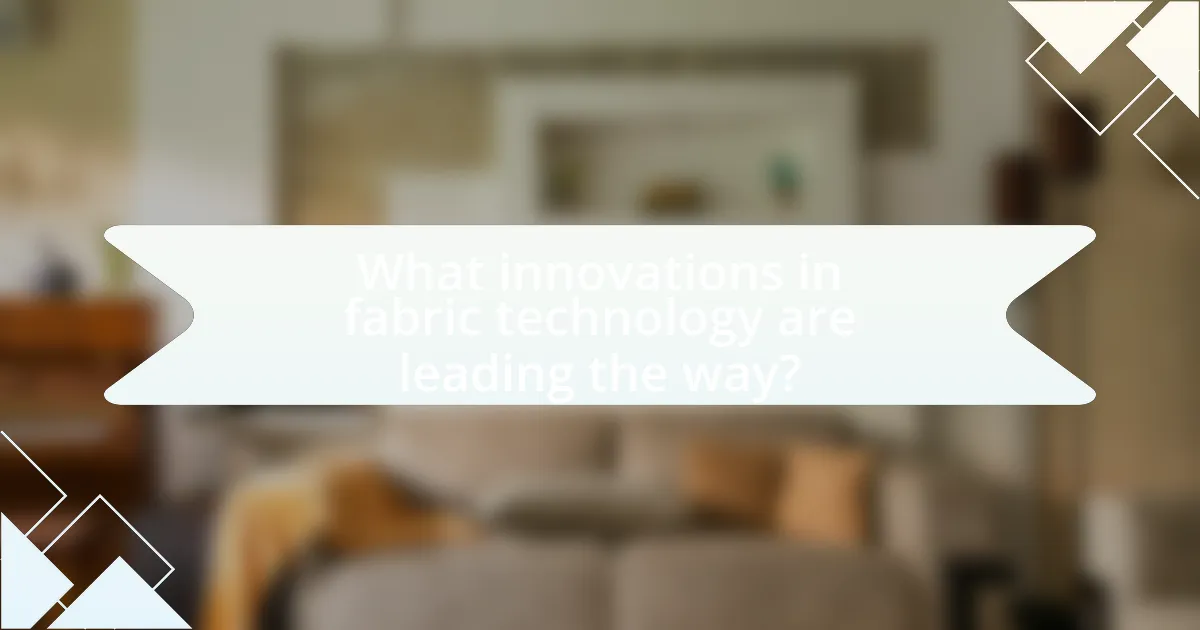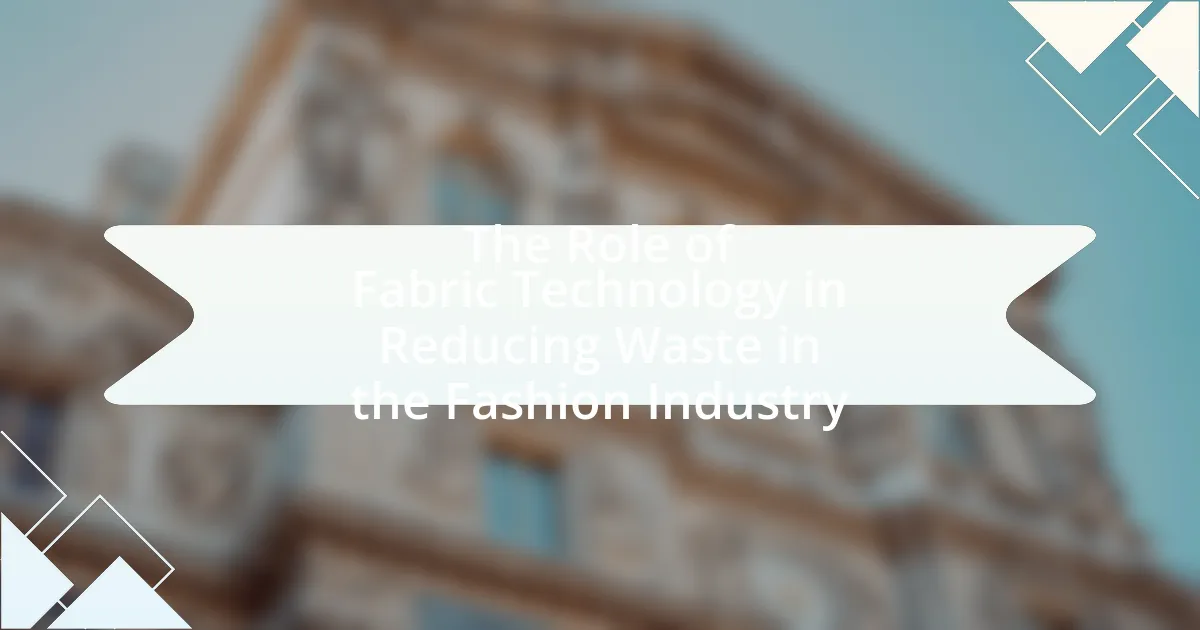Fabric technology is a pivotal element in the fashion industry, significantly contributing to waste reduction and sustainability. The article explores various advanced fabric technologies, such as biodegradable textiles, recycled fibers, and digital printing methods, which minimize environmental impact by decreasing reliance on virgin resources and reducing production waste. It highlights the importance of these innovations in enhancing the lifecycle of fashion products, addressing consumer behavior, and promoting sustainable practices. Additionally, the article discusses the challenges brands face in adopting new technologies and outlines best practices for integrating sustainable fabric choices into the fashion supply chain.

What is the role of fabric technology in the fashion industry?
Fabric technology plays a crucial role in the fashion industry by enabling the development of sustainable materials and innovative production processes that reduce waste. Advanced fabric technologies, such as biodegradable textiles and recycled fibers, contribute to minimizing environmental impact by decreasing reliance on virgin resources. For instance, the use of recycled polyester can reduce energy consumption by up to 75% compared to traditional polyester production, significantly lowering carbon emissions. Additionally, technologies like 3D knitting allow for precise manufacturing, which reduces fabric waste during production. These advancements not only enhance the sustainability of fashion but also align with consumer demand for eco-friendly products.
How does fabric technology contribute to waste reduction?
Fabric technology contributes to waste reduction by enabling the production of materials that are more durable, recyclable, and biodegradable. Advanced fabric technologies, such as those that utilize recycled fibers or innovative manufacturing processes, significantly decrease the amount of textile waste generated during production and at the end of a garment’s life cycle. For instance, the use of closed-loop systems in fabric production allows for the recycling of old textiles into new fabrics, thereby minimizing landfill contributions. Additionally, technologies like 3D knitting reduce fabric waste by creating garments directly from digital patterns, eliminating excess material. These advancements demonstrate a clear link between fabric technology and effective waste reduction strategies in the fashion industry.
What types of fabric technologies are most effective in minimizing waste?
Recycling technologies, such as closed-loop systems, and digital printing methods are the most effective fabric technologies in minimizing waste. Closed-loop systems recycle textile waste back into new fibers, significantly reducing landfill contributions; for instance, companies like Patagonia utilize this technology to create new garments from old ones. Digital printing minimizes fabric waste by allowing precise designs to be printed directly onto the fabric, eliminating excess material that traditional printing methods often generate. These technologies collectively contribute to a more sustainable fashion industry by reducing the overall environmental impact associated with fabric production and disposal.
How do these technologies impact the lifecycle of fashion products?
Technologies such as advanced fabric innovations and digital manufacturing significantly impact the lifecycle of fashion products by enhancing sustainability and reducing waste. These technologies enable the creation of materials that are more durable and recyclable, thereby extending the lifespan of garments. For instance, the use of biodegradable fabrics and waterless dyeing processes minimizes environmental impact during production. Additionally, digital tools like 3D printing and on-demand manufacturing reduce overproduction by allowing brands to produce items based on actual consumer demand rather than forecasts. This shift not only conserves resources but also decreases the volume of unsold inventory, which is a major contributor to waste in the fashion industry.
Why is waste reduction important in the fashion industry?
Waste reduction is crucial in the fashion industry because it minimizes environmental impact and conserves resources. The fashion industry is responsible for approximately 10% of global carbon emissions and significant water usage, with the production of a single cotton shirt requiring around 2,700 liters of water. By reducing waste, companies can lower their carbon footprint, decrease water consumption, and mitigate pollution, contributing to a more sustainable future. Furthermore, implementing waste reduction strategies can lead to cost savings and improved efficiency in production processes, making it economically beneficial for businesses.
What are the environmental impacts of waste in fashion?
The environmental impacts of waste in fashion are significant, contributing to pollution, resource depletion, and greenhouse gas emissions. The fashion industry generates approximately 92 million tons of textile waste annually, with a large portion ending up in landfills, where it can take decades to decompose, releasing harmful chemicals into the soil and water. Additionally, the production of clothing consumes vast amounts of water and energy; for instance, producing a single cotton t-shirt requires about 2,700 liters of water. This unsustainable cycle exacerbates climate change, as the decomposition of synthetic fibers in landfills emits methane, a potent greenhouse gas.
How does consumer behavior influence waste generation?
Consumer behavior significantly influences waste generation by determining purchasing patterns and product usage. For instance, consumers who prioritize fast fashion tend to buy more clothing items frequently, leading to increased textile waste; studies indicate that the average American discards about 81 pounds of clothing annually. Additionally, consumer preferences for convenience and single-use products contribute to higher levels of packaging waste, as seen in the rise of online shopping and food delivery services. This behavior not only amplifies waste but also challenges recycling efforts, as many materials are not disposed of properly.

What innovations in fabric technology are leading the way?
Innovations in fabric technology that are leading the way include the development of biodegradable textiles, recycled fibers, and smart fabrics. Biodegradable textiles, such as those made from organic cotton or Tencel, decompose more efficiently than traditional materials, reducing landfill waste. Recycled fibers, like those derived from post-consumer plastic bottles, significantly decrease the need for virgin materials, thus minimizing resource consumption and waste. Smart fabrics, which incorporate sensors and responsive materials, enhance garment longevity by allowing for real-time monitoring of wear and tear, ultimately contributing to reduced waste in the fashion industry. These advancements are supported by industry reports indicating that the use of recycled materials can cut down production waste by up to 50%.
How do sustainable fabrics differ from traditional fabrics?
Sustainable fabrics differ from traditional fabrics primarily in their environmental impact and production processes. Sustainable fabrics are made from renewable resources, such as organic cotton or recycled materials, which reduce reliance on fossil fuels and minimize waste. In contrast, traditional fabrics often utilize non-renewable resources and chemical-intensive processes that contribute to pollution and resource depletion. For example, the production of conventional cotton requires significant water and pesticide use, whereas organic cotton uses natural farming methods that conserve water and avoid harmful chemicals. This distinction highlights the role of sustainable fabrics in promoting eco-friendly practices within the fashion industry.
What materials are considered sustainable in fabric technology?
Sustainable materials in fabric technology include organic cotton, hemp, Tencel, and recycled polyester. Organic cotton is grown without synthetic pesticides or fertilizers, reducing environmental impact. Hemp requires minimal water and no pesticides, making it a highly sustainable option. Tencel, made from sustainably sourced wood pulp, is produced in a closed-loop process that recycles water and solvents. Recycled polyester, derived from post-consumer plastic bottles, diverts waste from landfills and reduces reliance on virgin materials. These materials collectively contribute to reducing waste and promoting sustainability in the fashion industry.
How do these materials affect production processes?
Materials significantly influence production processes by determining efficiency, waste levels, and overall sustainability. Advanced fabric technologies, such as biodegradable materials and recycled fibers, streamline manufacturing by reducing the need for chemical treatments and minimizing energy consumption. For instance, the use of recycled polyester can cut energy use by up to 75% compared to virgin polyester production, thereby decreasing carbon emissions and waste. Additionally, innovative materials can enhance the durability and lifespan of garments, leading to lower production frequency and reduced resource consumption over time.
What role does technology play in fabric recycling?
Technology plays a crucial role in fabric recycling by enhancing the efficiency and effectiveness of the recycling process. Advanced technologies, such as chemical recycling methods, enable the breakdown of textiles into their original fibers, allowing for the creation of new fabrics from recycled materials. For instance, companies like Worn Again Technologies utilize a patented process that separates polyester and cotton from blended fabrics, significantly improving recycling rates. Additionally, innovations in sorting technologies, such as AI-driven systems, increase the accuracy of material identification, ensuring that recyclable fabrics are properly processed. These technological advancements contribute to reducing waste in the fashion industry by facilitating the circular economy and minimizing the reliance on virgin materials.
What are the latest advancements in fabric recycling technology?
Recent advancements in fabric recycling technology include the development of chemical recycling processes that can break down polyester and other synthetic fibers into their original monomers, allowing for the creation of new, high-quality fibers. For instance, companies like Eastman and Renewcell have pioneered methods that enable the recycling of blended textiles, which were previously difficult to process. Eastman’s molecular recycling technology can convert waste plastics into new polyester, while Renewcell’s Circulose process transforms cotton waste into a dissolvable pulp for new fabric production. These innovations significantly enhance the efficiency of recycling operations and contribute to reducing textile waste in the fashion industry.
How effective are these technologies in reducing textile waste?
These technologies are highly effective in reducing textile waste by enabling more efficient production processes and promoting recycling. For instance, innovations such as digital printing and 3D knitting minimize fabric waste during manufacturing, with studies showing that digital printing can reduce waste by up to 90% compared to traditional methods. Additionally, advancements in fabric recycling technologies allow for the recovery of materials from discarded textiles, with the potential to recycle up to 95% of textile waste into new products. This combination of reduced production waste and enhanced recycling capabilities significantly contributes to lowering overall textile waste in the fashion industry.

How can the fashion industry implement fabric technology effectively?
The fashion industry can implement fabric technology effectively by integrating sustainable materials and innovative production processes that minimize waste. For instance, utilizing recycled fibers and biodegradable textiles can significantly reduce environmental impact, as evidenced by the fact that the global recycled textile market is projected to reach $5.4 billion by 2027, indicating a growing trend towards sustainability. Additionally, adopting digital printing technologies can decrease fabric waste by up to 90% compared to traditional methods, as it allows for precise designs and reduces excess material. By focusing on these strategies, the fashion industry can enhance efficiency and sustainability in fabric production.
What strategies can brands adopt to integrate fabric technology?
Brands can adopt several strategies to integrate fabric technology effectively. First, they can collaborate with textile innovators to develop sustainable materials that reduce environmental impact, such as recycled fibers or bio-based fabrics. For instance, brands like Adidas have partnered with Parley for the Oceans to create shoes made from ocean plastic, demonstrating a successful integration of innovative fabric technology.
Second, brands can invest in research and development to enhance the functionality of fabrics, such as moisture-wicking, temperature regulation, or self-cleaning properties, which can lead to longer-lasting products and reduced waste. Companies like Nike have utilized advanced fabric technologies to improve performance while minimizing waste during production.
Third, implementing digital tools like 3D design and virtual sampling can streamline the design process, allowing brands to test and iterate on fabric technologies without producing physical samples, thus reducing material waste. Brands such as Zara have adopted these technologies to optimize their supply chain and minimize excess inventory.
Lastly, educating consumers about the benefits of advanced fabric technologies can drive demand for sustainable products, encouraging brands to prioritize these innovations. Brands like Patagonia actively promote their use of recycled materials and environmentally friendly practices, fostering consumer awareness and loyalty.
How can collaboration with tech companies enhance fabric innovation?
Collaboration with tech companies can enhance fabric innovation by integrating advanced technologies such as artificial intelligence, data analytics, and smart textiles into the fabric development process. This partnership allows for the creation of sustainable materials that are not only environmentally friendly but also functional, such as fabrics that can monitor temperature or moisture levels. For instance, companies like Adidas have collaborated with tech firms to develop fabrics made from recycled ocean plastics, significantly reducing waste while improving performance. This synergy between fashion and technology leads to innovative solutions that address both consumer needs and environmental challenges in the fashion industry.
What are the challenges brands face in adopting new fabric technologies?
Brands face several challenges in adopting new fabric technologies, including high costs, lack of expertise, and supply chain complexities. The initial investment required for advanced fabric technologies can be prohibitive, especially for smaller brands, as they may not have the financial resources to implement these innovations. Additionally, many brands lack the technical knowledge and skills necessary to effectively integrate new materials into their production processes, which can lead to inefficiencies and increased waste. Furthermore, the existing supply chain may not be equipped to handle new fabric technologies, resulting in logistical hurdles and potential disruptions in production. These factors collectively hinder the widespread adoption of innovative fabric technologies in the fashion industry.
What best practices can be followed for sustainable fabric use?
Best practices for sustainable fabric use include selecting organic or recycled materials, implementing efficient production processes, and promoting circular fashion principles. Organic materials, such as cotton grown without synthetic pesticides, reduce environmental impact, while recycled fabrics minimize waste by repurposing existing textiles. Efficient production processes, like waterless dyeing technologies, decrease resource consumption. Additionally, circular fashion encourages the design of garments for longevity and recyclability, which aligns with the principles of reducing waste in the fashion industry. These practices collectively contribute to a more sustainable fabric use, addressing the environmental challenges posed by traditional textile production.
How can brands educate consumers about sustainable fabric choices?
Brands can educate consumers about sustainable fabric choices by providing transparent information on the environmental impact of different materials. This can be achieved through detailed labeling that includes data on the lifecycle of fabrics, such as water usage, carbon footprint, and biodegradability. For instance, a study by the Ellen MacArthur Foundation highlights that educating consumers about the benefits of sustainable fabrics can lead to a 30% increase in eco-friendly purchasing decisions. Additionally, brands can utilize social media campaigns and workshops to engage consumers, showcasing the advantages of sustainable fabrics and how they contribute to reducing waste in the fashion industry.
What role does transparency play in promoting sustainable fabrics?
Transparency plays a crucial role in promoting sustainable fabrics by enabling consumers to make informed choices about their purchases. When brands disclose information about their sourcing, production processes, and environmental impact, it fosters trust and accountability. For instance, a study by the Fashion Transparency Index found that brands that provide detailed supply chain information are more likely to be perceived as sustainable by consumers. This transparency encourages companies to adopt better practices, as they are held accountable for their environmental and social impacts, ultimately leading to a reduction in waste and promoting sustainable fabric technologies.
What are the future trends in fabric technology for waste reduction?
Future trends in fabric technology for waste reduction include the development of biodegradable textiles, the use of recycled materials, and innovations in digital printing. Biodegradable textiles, such as those made from organic cotton or hemp, decompose more efficiently than traditional fabrics, reducing landfill waste. The use of recycled materials, like polyester made from plastic bottles, significantly decreases the need for virgin resources, thereby minimizing waste during production. Innovations in digital printing allow for on-demand production, which reduces excess inventory and waste associated with traditional printing methods. These trends are supported by industry reports indicating a growing shift towards sustainable practices, with the global sustainable textile market projected to reach $8.25 billion by 2025, reflecting the increasing demand for eco-friendly solutions in fabric technology.
How might emerging technologies reshape the fashion industry?
Emerging technologies are set to reshape the fashion industry by enhancing sustainability and efficiency through innovations like 3D printing, AI-driven design, and smart textiles. These technologies enable brands to produce garments on demand, significantly reducing overproduction and waste, which is a major issue in traditional fashion manufacturing. For instance, 3D printing allows for precise material usage, minimizing excess fabric waste, while AI can analyze consumer trends to optimize inventory levels. According to a report by McKinsey & Company, the adoption of such technologies could reduce the fashion industry’s carbon footprint by up to 30% by 2030, demonstrating their potential impact on sustainability.
What predictions can be made about the evolution of fabric technology?
Predictions about the evolution of fabric technology indicate a significant shift towards sustainable and smart materials. Innovations such as bioengineered fabrics, which utilize organic materials and processes, are expected to reduce environmental impact and waste in the fashion industry. For instance, companies are increasingly adopting recycled fibers and biodegradable textiles, which can minimize landfill contributions. Additionally, advancements in smart textiles, capable of monitoring wear and environmental conditions, will likely enhance garment longevity and reduce the frequency of disposal. Research from the Ellen MacArthur Foundation highlights that transitioning to circular fashion practices, including innovative fabric technologies, could lead to a 70% reduction in textile waste by 2030.

Leave a Reply